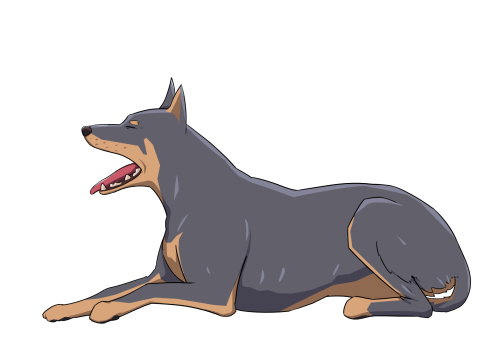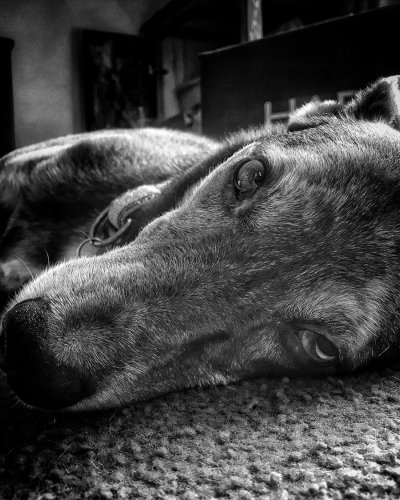Therapeutic Regulation of Canine Arousal Dysfunction
Many dogs struggle with arousal dysfunction, an exaggerated reaction to environmental stimuli. This overreaction can be problematic for both the animal and its handler. Therapeutic treatment uses holistic methods to help these dogs better regulate their internal arousal systems, promoting happier, healthier lives.
What is Arousal?

The word arousal often causes a giggle or smile, as it is regularly associated with bedroom antics. However, the meaning of arousal is to describe the state of awakeness or excitement level. It is a common word in the canine industry that refers to a dog's level of excitement at a specific moment. A culmination of internal and external factors causes this level of arousal.
Internal factors contributing to a dog's arousal state include physiological health, emotional well-being, and biological makeup. In contrast, external factors include their social setting or environmental stimuli. The state of arousal and its appropriateness for a situation are important as they help the dog complete tasks. Higher arousal tasks might include catching a frisbee, and lower arousal tasks include recovering after exercise.
While the medical definition of arousal is a state of alertness and readiness for action, it is important for dog owners to understand different states of arousal and when these are beneficial or potentially harmful. Sometimes, this alertness can be excessive, which is termed hyperarousal. Alternatively, a limited or reduced arousal response can be exhibited, termed hypoarousal.
In some situations, hyperarousal is desirable as a prompt reaction to a life-threatening situation; high arousal levels may also benefit dogs competing in sports. Hypoarousal, on the other hand, is welcome when it's time for rest and physical recharging. When a dog's state of arousal doesn't match the situation, is inappropriate, or where the dog struggles to move freely between arousal states, dysfunctions arise.
Dogs that experience arousal dysfunction often have a reduced quality of life due to the physical reactions that occur within the body and the mental and emotional load it causes. Owners of dogs with arousal issues can also find the situation stressful; this can create a negative cycle whereby both the dog and owner's state of stress begin to affect each other negatively.
How to Spot Arousal Dysfunction in Dogs?
Canine arousal dysfunctions can lead to extreme stress, anxiety disorders, and emotional imbalance. These disorders directly affect the neurological system and can lead to other health issues that affect a dog's overall physical and emotional health. Outward behavioural problems are often the first sign that owners notice. However, it's important to understand that changes are already occurring in the brain chemistry before these behavioural signs show.
Owners play a vital role in spotting arousal dysfunctions in their dogs. They should focus on key indicators, such as their dog's outward behaviour and body language. It's also important for owners to check in with their own feelings. If they find themselves overwhelmed by their dog's behaviour, it could be a sign their dog is struggling with hyperarousal, which needs attention.
Understanding the complexities of canine arousal dysfunctions allows owners to take action early and work towards a positive outcome for their dog. The first step is to understand canine arousal, what is optimal, what is excessive, and what is a deficient response.
Owners are more likely to notice excessive arousal levels, often associated with unwanted behaviours. However, hypoarousal, a state of low arousal, can be more challenging to identify. It may manifest as a shutdown response and is often linked to behaviour suppression training.
Most of us are familiar with the terms "fight, flight, freeze responses." These can be linked to states of arousal, with the first two being associated with heightened arousal and the latter with hypoarousal. The fight-and-flight response is heavily associated with a dominant sympathetic nervous system, designed as a life-saving response. However, in this state, the dog loses its impulse control abilities and can react impulsively and unpredictably.
In contrast, the freeze response is associated with a dominant parasympathetic system and limits the dog's ability to react outwardly. This can foster a deep fear and affect the dog's psyche, especially if the dog is repeatedly exposed to the stimuli causing this response. Fear-related aggression in these dogs does not always follow the typical canine ladder of aggression, but rather, they can seemingly jump to dangerous red zone behaviours without warning.
But how can we tell when our dog's state of arousal is sub-optimal or even detrimental to their well-being? Early signs of arousal dysfunction are typically associated with numerous outward signs. The dog may seem overly cautious, focused, intense, or active in a situation that would not normally cause such a reaction in an arousal-balanced animal. Alternatively, dogs may seem overly compliant; unfortunately, this behaviour can cause much confusion among owners. We generally strive for well-mannered dogs, but if this comes from fear, suppressed behaviour, or hypoarousal, then we must consider the detrimental psychological and physiological effects it has on our dogs.
In both hyperarousal and hypoarousal, invisible to the eye, physiological changes occur in the dog's body, driven by the unconscious autonomic nervous system. These changes affect breathing, heart rate, blood pressure, pupil dilation, gut function, and much more. This demonstrates that the body and mind are intrinsically linked and that working on creating a balanced arousal response to a wide variety of environmental stimuli will positively affect the dog's emotional and physical well-being.
Since arousal in a dysfunctional form occurs in situations where such behaviour is considered abnormal, it is crucial to help the dog learn to regulate the level of arousal. Failure to treat this condition reduces the dog's quality of life and the relationship with the owner.
What Triggers Arousal Dysfunctions?
Arousal dysfunctions are often linked with other conditions or behavioural issues, such as separation anxiety, thunderstorm phobia, underlying anxiety, compulsive disorders, post-traumatic stress disorder, or dog bites. But what triggers the dog to have problems regulating their level of arousal?
As mentioned earlier, internal and external sources are involved, and some individual dogs or even breeds of dogs may be more predisposed to issues with their ability to regulate their arousal systems. There is a big fancy word we use when looking at factors that can influence outward behaviour: 'biopsychosocial', which combines the words 'biological' 'psychological' and 'social'. Because there isn't just one thing that can trigger dysfunction, it's important that we provide a safe environment for dogs to learn appropriate behaviours, and we teach them to move through states of arousal freely.
When arousal dysfunctions suddenly appear, it is often a good idea to consult a canine osteopath who is trained to consider internal and external influences on the body and mind and aid in regulating the nervous system through manual therapy.
Psychological and emotional changes can go completely unnoticed by the untrained eye, so it is important to take the time to check in with your dog regularly and pay attention to changes in their level of alertness. Acting early reduces the likelihood of dysfunctional patterns being created, which can be harder to address.
Physiological Arousal and Environmental Triggers
To maintain homeostasis, the dog's body constantly reacts and adjusts to its environment; the responses that occur within the body and mind determine the outward physiological arousal response. When we consider environmental triggers, we look at things external to the dog that create a response within the dog's body and mind. Thinking back to the word biopsychosocial, we can see that the environmental triggers are heavily associated with the social setting.
Exposing the dog to intense or continuous environmental stimuli without rest periods can significantly increase the likelihood of creating arousal dysfunctions. Often, owners are mistakenly guided by their subjective impression and conclude based on their experience of the environment whether it's too stimulating or not. Their dog, on the other hand, can look at circumstances from a completely different perspective—the one that should always be imperative when dealing with arousal dysfunctions.
Owners can make their own observations and create a list of environmental stimuli their dog is triggered by. Start with the easiest triggers first; these create the biggest arousal response in your dog and may include moving prey animals, passing cars, doorbells, other dogs, thunder, etc. Think about your dog and what are triggers for them. Once you've got a list of the big-ticket items, you can work your way down to smaller triggers. Rating them on a scale of 1 - 10 will help you keep track of which are the most stimulating and which have a minor effect.
Although it may be tempting to focus on the environmental stimuli that result in bigger behavioural signs, the smaller items can have a cumulative effect, adding up and creating a heightened arousal response. This is known as trigger stacking, which will be discussed further in the article.
Psychological Arousal and Internal Triggers
Unlike environmental stimuli, arousal levels originating from the dog itself—as a result of mental health issues or difficulties regulating emotions, often not separate—can be more challenging to detect and correct. The psychological arousal is a consequence of neurological connections in the brain that are strengthened by frequent repetition: the more often a behaviour is performed, the more "normal" the dog considers it. Neural pathways that have been strengthened by a continuous specific reaction in the past can manifest in current events, triggering the same unwanted reaction of dysfunctional arousal, even though, at first glance, the two situations are not connected.
Biological factors play a significant role in how the mind interprets signals sent from within the body; underlying issues such as pain, tension, restrictions of motion, gut health, general brain chemistry and other factors all contribute to how 'safe' the body feels. Just as trigger stacking can occur from multiple external factors, it can also occur with multiple internal triggers negatively affecting the dog's mental health.
Is Arousal Dysfunction Rare in Dogs?
It's important to recognise that arousal dysfunction is not exclusive to dogs lacking training or engagement. Even owners who are deeply committed to training, including those involved in intricate dog training, can find themselves in a situation where their dog struggles to cope with stress from environmental stimuli.
An example comes from a study conducted in 2006 on dogs trained to withstand even very high levels of arousal—companion dogs that work in animal-assisted therapy. Dorit Karla Haubenhofer and Sylvia Kirchengast observed the level of arousal shown by therapy dogs by measuring the level of cortisol in their saliva. Cortisol hormone is one of the main stress hormones and indicators of altered physiological states in response to physiological arousal in most mammals, including dogs.
In their research, Haubenhofer and Kirchengast discovered that activities such as travelling to a new place, being in unfamiliar surroundings and around unfamiliar people, and even the therapeutic work itself increased physiological arousal. By adding the frequency variable to such stimuli from the environment, they concluded that cortisol concentrations increased significantly with the number of sessions. The conclusion of the research shows that therapy dogs need enough rest in order not to cross the arousal threshold and enter a state of chronic stress and hyperarousal.
Therefore, even dogs trained to withstand higher levels of physiological arousal need enough time to calm down and, consequently, bring arousal to an optimal level. Otherwise, permanent exposure to excessive environmental stimuli can lead to crossing the threshold and reaching a negative state of hyperarousal or a shutdown hypoarousal state of perceived compliance.
Dogs acting impulsively, panting, jumping, barking, and vocalising are external stress indicators that handlers might look for when assessing their dog. However, it's essential to remember that internal factors such as increased heart rate and blood pressure, which remain hidden, can potentially harm the dog's physical health.
Ways to Help a Dog With Arousal Dysfunction
Keep in Mind Their Characteristics and Abilities

When working with your dog, always keep in mind their individual characteristics. Some dogs are inclined to a more active lifestyle and need more challenging mental stimulation and enrichment. These dogs may have a higher arousal threshold than others, who are more prone to a lower-activity life. The key is to match the amount of stimulation and rest periods that are right for your dog, ensuring that they can engage equally in relaxation and optimal levels of arousal for training, work or play.
Dogs that have been bred for centuries for herding, having had their genes and physical construction selected to help them perform their work for long hours over various terrains in all weather conditions, will have vastly different abilities and needs than dogs that were bred as companion animals. Special attention should be paid to these extremely athletic dogs to ensure they have enough time to rest and regulate their emotions so that their high energy doesn't turn into hyperarousal.
Avoid Trigger Stacking
As mentioned earlier, trigger-stacking (also called situation-stacking or stressor-stacking) can play a significant role in overwhelming the dog and causing hyper or hypoarousal situations. It refers to separate, generally short-lived situations that occur one after the other without enough time in between for the dog to calm down, regulate or process the information in a useful or productive manner. These situations can be good or bad, but if they lead to excitement or anxiety building up, in the end, they will create an arousal state in which the dog is no longer able to relax or control their impulses.
One often overlooked factor is how long the effects remain in the body after a triggering event. Depending on the severity of the situation, it can, without intervention, take days for the body to regulate. Although it is vitally important to allow the dog enough time for rest, this is often insufficient, especially if the dog's body and mind are stuck in a stress state.
Change the Environment

Examples from dog shelters best demonstrate that the environment can be extremely stressful for a dog. Shelters are usually very noisy and highly stimulating, and many dogs in shelters struggle with arousal disorders.
In an article titled "Effects of Olfactory and Auditory Enrichment on the Behavior of Shelter Dogs", published in 2020, researchers observed shelter dogs and the effects of exposure to strong stimuli from which they could not move away, as well as their response to calming reinforcements such as lavender scent, music and dog-calming pheromone (DAP). The results suggest that even small changes in the environment of shelter dogs can positively affect their behaviour, which could help improve the quality of their experience while in care.
Therefore, if a dog is showing signs of arousal dysfunction in situations that might seem less stressful than noisy dog shelters (but require an equally serious approach), even a small change in the environment and an attempt to calm the dog can have a powerful effect on the arousal level. The above example demonstrated that a reduction in arousal levels can be achieved by targeted sensory enrichment of the environment.
Therapeutic approach to helping dogs
Many people seek out a behaviour modification plan from dog trainers when dealing with arousal dysfunctions; because outward behaviour is often most noticeable, it makes sense that training will help.
However, because this issue significantly impacts the dog's psyche and physical health, affected dogs need to learn to calm their vast neurofascial system, which runs throughout the body. Therapeutic means can help retrain the somatic nervous system and settle an overactive autonomic nervous system to help the body and mind feel safe (within the natural limits of the dog's biological makeup).
Consulting with specially trained animal osteopaths can open up a world of potential improvement for your dog's body and mind, allowing them to become far more successful in adjusting their arousal response.
Desensitizing Technique
When thinking of mental health treatments and home remedies for dogs with arousal dysfunction, desensitisation comes as a simple yet powerful technique. Slowly but surely, it can assist the dog in learning to control its impulses and lower its arousal, even when the environment doesn't allow it.
To achieve this, it is vital to keep a sufficient distance from the source of arousal so that the dog feels comfortable but is still exposed to the trigger to some extent. For example, if other dogs in the park cause a dysfunctional arousal reaction in your dog, keep your dog at a distance where it can see other animals but does not react. Every good behaviour (sit, stay, focus) should be rewarded, and if the dog starts responding to the stimuli—step away even further. This way of exposing the dog to its triggers will change the dog's association when the trigger is present, but remember that this is not a change that will happen overnight.
This method is often used before considering a therapeutic approach; doing so can increase the time taken to see improvements since the body and mind can still be in a state of stress that impedes learning. Therefore, it is advisable first to seek to regulate the body, allowing the learning to follow naturally.
The Off-switch

The 'off' switch for a dog is an often misunderstood term. Firstly, we need to ask ourselves what is off. If we consider it a state where the dog is not working but is ready to go the moment a command is given, we must ask: Are they really off? This state of readiness does not allow the body to conduct the natural repair functions necessary for optimal health efficiently. I would much rather trainers call this state the ready state, as this prevents confusion.
Another area of confusion with the off-switch is situations where dogs exhibit a low arousal state, which is associated with learned hopelessness or suppressed behaviour. This is a maladaptive state that is detrimental to the dog's well-being.
Instead, when discussing the 'off-switch,' we should consider a state similar to meditation for people—it helps reset the mind and relaxes the body. Contrary to popular belief, dogs are born with an innate ability to switch off, and we see this readily displayed in puppies who play and then shift into periods of relaxation, often falling asleep. As they age, however, many dogs become over or understimulated, causing long-term stress; they may forget how to engage in a state of rest due to neural pathways and brain chemistry that inhibit relaxation.
Thus, it is crucial to promote relaxation and teach our dogs when their work or game is over so they can shift their bodies into a recovery mode, which is essential in any canine fitness training program. Consider using a specific cue to let your dog know they are finished and no longer need to be prepared for action.
The word with which you end the activities must be easy to remember and always be the same—never change the word with which you end the activities, as this will only confuse your dog—to indicate to the dog that it is time to calm down. Likewise, once you say your chosen word, be persistent in not engaging anymore, even though the dog might still push you for a while. After some time, your dog will realize that this is truly an end to the game or any other activity and will automatically calm down.
Manual Therapy and Exercises to Help Your Dog
Manual therapy sessions are designed to help the dog's nervous system regain balance. Hyper or hypo arousal in dogs leads to activating different parts within the body: hyperarousal activates the sympathetic nervous system, which increases blood flow to the muscles and reduces blood flow to the organs; hypoarousal draws blood away from the muscles (which is why the freeze response occurs) towards the organs due to the activation of the parasympathetic nervous systems.
In a healthy body, these systems are balanced, and the dog can move freely through states of arousal in response to internal and external stimuli. When this balance is upset, manual therapy efficiently returns functions and promotes health within the body and mind. Therapies such as animal osteopathy are designed to focus on the many interlinked bodily systems that are affected and reinstate a functional, healthy state within the body, alleviating stress from the mind.
Arousal Dysfunctions: What Not to Do
We always advise against aversive tools or techniques to correct dog behaviour or while working with arousal dysfunctions. Tools such as shock collars, prong collars, and choke chains act through forced compliance. They can negatively affect the dog's perception and emotional response to the stimuli that cause the arousal dysfunction. The long-term damage of using these punishing methods for overreacting to sound, sight, or event can create more fear and further problems, lessening the dog's ability to feel safe and balanced.





Leave a comment